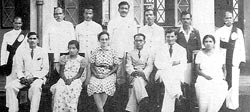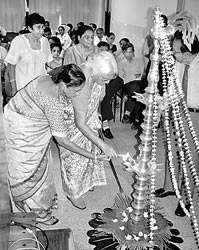
From ‘Thimbirigey’ to ‘Nona Waattuwa’The Past Unfolded: Paediatrics and Child Care in Sri Lanka by Prof. Manouri P. Senanayake. This book’s unusual title both intrigued and rather intimidated me. In spite of having been briefly involved in medical administration I was not enamoured at the prospect of ploughing through a dull tome on medicine written by a medical doctor. But, to my pleasant surprise I found the book an exhilarating read – a comprehensive narrative of the development of paediatrics interestingly placed within the context of Buddhist philosophy and the history of Europe, India and Sri Lanka. I confess I never expected a young medical doctor to be equally knowledgeable of Roman and medieval European history as well as of Indo-Aryan civilization. With equal felicity she quotes Cicero, the Old Testament , Manussmriti, Sigalovada Sutta, Buddhadasa’s Sarartha Sangrahaya as well as Charles Darwin – not in heavy scholastic style but with simple lucidity to place the concept of child care in its historic context.
Dr. Senanayake then gets into her stride when she comes closer home with the crude beginnings of modern (i.e. European) medicine in ‘Ceylon’ in the military hospitals of the Portuguese , Dutch and British Colonial powers. Gradually ‘native medicine’ [Ayurvedha,Siddha,Unani] ceased to be the first preference of village folk who now sought treatment in the many hospitals the British established far and wide. She then goes on to chart the gradual evolution of paediatric medicine as a separate discipline and the related saga of the rise of [what is claimed to be] the largest children’s hospital in the world, the Lady Ridgeway Hospital [LRH], from very modest beginnings. It is an account replete with human interest and fascinating pioneers of whom she writes with admiration and occasionally, amusement. I neither have the competence to analyse the development of paediatrics in Sri Lanka nor the advancement of the LRH to the honoured position it now holds in the world of health care. But I cannot resist referring to various fascinating snippets from the past with which the writer spices her narrative. The first, from a letter in 191 by an English Nursing Sister Lucy shows, sadly, how far our people’s behaviour has now deteriorated: “Having nursed my own countrymen, alas! The difference is perceptible. How often my young nurses in England have had to appeal to me. These seem a simple moral, quaint sort of people, their religion seems so much one them.”
On the subject of nurses Dr. Senanayake reminds us that, almost one thousand years before Florence Nightingale, Parakrama Bahu the Great “sent females to Ramanya Desa to nurse soldiers when he invaded the country”! Her sense of history is admirable. In lighter vein I quote , without comment, a popular patent medicine advertised by Colombo Apothecaries Co, in 1899 : ‘Celerine’ [ for nerves and alcohol excess] The book is a superb compendium of the development of paediatric care and hospitals, especially the great Lady Ridgeway Hospital whose pioneer colossi Drs. L.O.Abeyratne, C.C. de Silva, Stella de Silva, Priyani Soysa, and Grace Barr Kumarakulasingam she writes of with affection and respect. A wonderful collection of rare and valuable old pictures rounds off the book. In conclusion I refer to where we all began- the centuries old thimbirigey, the labour room of yore, dark, cool, clay-floored and equipped with the vili rehena to which the pregnant mother clung when giving birth . The writer leaves us with her tale of the Nona Waattuwa [ as the Sinhalese call the LRH ] and the mystery of this strange name. Is the original Nona none other than the pioneer woman doctor, the half-Sinhalese Dr. Mary Nona Fyshe? Or is she the white Governor’s Lady [Nona] whose portrait graces the lobby? Or does it honour the country’s nameless nonas who have thronged its corridors seeking solace for their sick children? The mystery will last, I am sure, as long as the LRH does. |
||||
|| Front
Page | News | Editorial | Columns | Sports | Plus | Financial
Times | International | Mirror | TV
Times | Funday
Times || |
| |
Copyright
2007 Wijeya
Newspapers Ltd.Colombo. Sri Lanka. |

